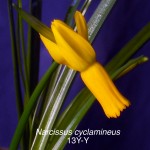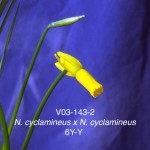The top photo is of N. cyclamineus 13Y-Y. This is a particularly nice clonal form . Now up to seven bulbs (although most are DN and TN this year).
The photo below is of V03-143-2 which is a cross of an exceptional form of N. cyclamineus from the Smith Garden times a nice form of N. cyclamineus seed raised from Wisley seed.
As some of you may have guessed, both photos are of the EXACT same flower. The bottom has the foliage held back and is taken from a slightly different angle. The point of the matter is that if I had made the cross as: N. cyclamineus x self, it could legally be shown as Narcissus cyclamineus.
I record ALL my crosses. This cross was really made under V03-143 and this was clone #2 hence V03-143-2. Due to the fact that I carried and recorded this cross under number, according to the rules it MUST be exhibited and REGISTERED as a 6Y-Y. The dilemma is that as a 6Y-Y a perfectly beautiful form of the species becomes “submerged” in amongst the hybrid Div. 6’s with no way for anyone to consider it or even recognize it as a nice form of the species. If a hybridizer keeps flowers under a name, number or some form of designator, the resulting seedling must be shown, registered and named in its respective hybrid Division. If a hybridizer does not use a name, number or designator, presumably the exact same cross may be exhibited, registered and named as a species. Points for hybridizers to ponder.
I’m NOT at all complaining about the rules. I simply thought this concrete example might illustrate the rules so that they could be easily understood by everyone.
Steve



Steve, I don’t see the problem. Yes, you’ve recorded a seedling number during its early years, but you have decided it’s not distinctive enough to give it a name and register it in Div. 6. So, I see no problem entering it in Div. 13 as N. cyclamineus, WITHOUT your cross number.
Mary Lou
Mary Lou,
Let’s assume that this is the most dramatic, super form of N. cyclamineus ever seen. It’s NOT but let’s assume it so. If I name it ‘Superb’, it does get submerged into all the hybrid Div. 6’s. In many plant groups they ardently cherish, maintain, and conserve the finest forms of the species. Once it is relegated to Div. 6 there really isn’t any way to tell that it really is a species without a chunk of study and research.
I also believe that species ought to compete with species and not hybrids. That’s how excellent forms of species are currently recognized and awarded.
That’s really my only point and I don’t really see this as a major problem either. Just something for hybridizers to consider prior to naming.
Steve
Steve,
I guess what you’re saying is that the daffodil world is out of sync with the rest of the horticultural world. I don’t know where you address that issue.
But, regarding your excellent N. cyclamineus, why can you not sell it as N. cyclamineus select form or some such thing? I have vague memories of Grant Mitsch selling “N. jonquilla select” many, many years ago as a superior form of N. jonquilla. I’d have to look through old catalogues, but my recollection is that he had bred a strain of N. jonquilla that was superior, and that’s what he was using in his breeding program, and offering to his customers.
Mary Lou
My two cents doesn’t make a lot of difference, but I suppose I see things a bit differently regarding this. I’m of the mindset that if crosses are made within a species to improve on certain qualities or attain attributes superior to the parents, there should be nothing wrong with naming the worthy offspring as a selection of the species. This is done all the time in other plants (Lonicera sempervirens ‘Major Wheeler’ or Buddleja davidii ‘Black Knight’) that resulted from crosses within the species rather than plants from within a genus like Alec Gray’s daffodil, ‘Sundial’ 7Y-Y (Narcissus rupicola x Narcissus poeticus). In other words, if Steve comes up with a killer form of Narcissus jonquilla (and the parents really are N. jonquilla x N. jonquilla, not N. assoanus x N. jonquilla), or I come up with a perfectly formed N. fernandesii), why not call it N. jonquilla ‘Insert Name Here’ or N. fernandesii ‘Name of Selection’ and show it as such?
Steve mentioned the problem with species crosses being forced to compete with hybrids in their respective divisions rather than Division 13. He makes a valid point that once a flower is “relegated to [its division] there really isn’t any way to tell that it really is a species without a chunk of study and research.” By taking my approach, on the other hand, I could see “improved” forms of a species dominating Division 13 (depending on who’s judging), and an entire range of expression found in some species might be forced to the back of the pack because of selected introductions and judges’ personal tastes/prejudices. So I’m not quite sure where species selections should be shown, but I firmly believe that they should be named as such (always use the species name & number or species name ‘selection name’) to indicate that they are species selections.
Then again, does anyone really care about this, except hybridists? There are so few of us. We pretty much know what’s out there and from where it came. Maybe flowers don’t end up lost in the shuffle as long as we’re really on top of our game. As for everyone else, namely the less than serious gardener or exhibitor (who doesn’t make crosses), it probably doesn’t matter. Either way, I think it’s great that Sid DuBose made strides with improving the form of N. assoanus, and Dick and Elise and Steve have done wonders with improved versions of N. jonquilla and N. cyclamineus.
Perhaps a solution to ensuring that named or numbered flowers from species crosses are not oblivious is for a prize or trophy to be offered at our shows for the Best Species Selection (and require that the entries result from parents from the same species, perhaps with at least one parent being numbered or named). This way, species selections that get lost in the shuffle among their Divisional cousins can be recognized, while standing out among the others in Division 13.
Greg Freeman
Walhalla, South Carolina, USA
http://www.SouthernEdition.com
Mary Lou and Greg,
Great comments. Thank you both for the thoughtful postings.
I do not believe that “we are out of synch with the rest of the horticultural world”. Some plant groups may handle similar issues worse, the same, or better. If pressed, I’d say that the current methodology simply isn’t an elegant solution from my perspective. I really don’t see it as a big problem, simply a minor dilemma for hybridizers to consider if they are working with species.
I do feel strongly that really excellent forms of species should be conserved and cherished. The current procedure discourages that aspect which I find unfortunate. From a pure hybridizing perspective, excellent species forms do help to make excellent babies.
Re: Mitsch N. jonquilla Select – As I understand it, this was a much improved strain or grex and not a clonal Selection. My example of a particularly nice form of N. cyclamineus is from a clone increased via bulb division. Selling such and distributing them is not a concern or even enters into the equation.
Greg, sincere thanks for your posting! I do agree that most everyone will be busy studying the inside of their eyelids about now. I also agree that it is a tiny, tiny subset that cares about or can relate to the issue.
I’m personally less than thrilled with the idea of another award. We might have too many as it is. At first pass, I do like your idea using the species name followed by a clonal name but would like some amount of time to think more about it. I will comment further in the future. Thanks again!
Steve